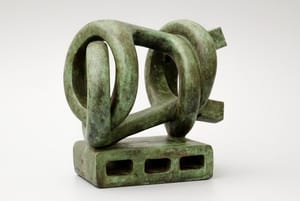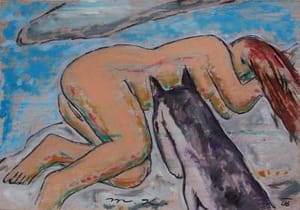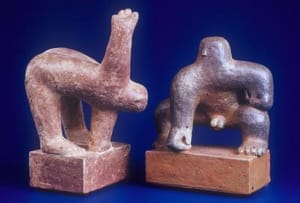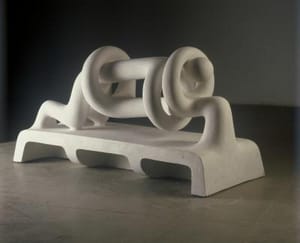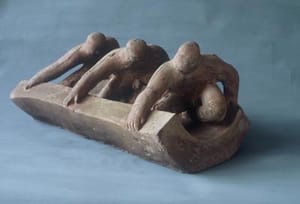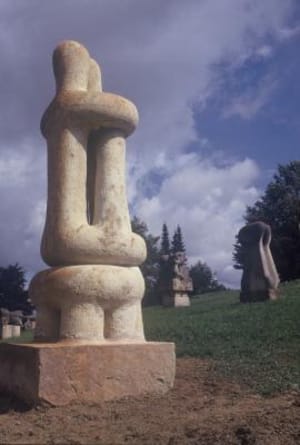- First Name
- Marius
- Surname
- Kotrba
- Born
- 1959
- Birth place
- Čeladná
- Place of work
- Rožnov pod Radhoštěm
- Website
- www.kotrbamarius.cz
- Died
- 2011
- Lived and worked in
- Rožnov pod Radhoštěm
- Keywords
- CSU Library
- ↳ Find in the catalogue
About artist
Marius Kotrba, painter and draughtsman, is these days regarded as one of the most important members of the generation of the eighties, even though he only found his original expressive language at the beginning of the nineties. He is an unashamed traditionalist. He attempts to retain the principles of figurative sculpture as a phenomenon which is integrally linked with the history of European culture. His atelier at Ostrava University is perhaps the only one in the Czech Republic where the classical figure is not simply a traditional basis of three-dimensional artefacts which students give up as quickly as they can, but is the point at which all their studies are aimed.
Though Kotrba studied sculpture during the eighties at the Prague Academy, the customary division into an artist’s own work and obligatory school work in his case was manifest in a special kind of double life: he sculpted out of a sense of duty at the academy and regarded his main activity as painting, which he regularly exhibited at Confrontations. He only returned to sculpture having completed his studies at the academy. In this respect an important impulse was a meeting with Hana Wichterlová. Kotrba began to realise her sculptures for her in definitive material. It was Wichterlová who restored his faith in sculpture and directed him toward a vital principle, as we know it from her famous sculptures Sprout, Pip, Seed or Core, in which the substance of the sculpture creates an impression that it is pervaded by an internal organic energy.
The motif of the cube makes its appearance in the first sculptures at the end of the eighties. At first these were expressively stylised figures, whose extended limbs were limited by the shape of the block. Later they became larger or smaller clusters of small figures in various positions who contend with the cube, attempt to budge it or hold it firmly in position on their backs. The motif of compression, the tight hugging of all four limbs, gives the impression that the cube is not here simply a burden but blends with their figure as a fatal burden.
In the motif based on “contending with a cube” it is possible to follow Kotrba’s path from existential gloom to the vital principle referred to above. The work Cube is dated 1992 and is wrapped up in a spider like figure. However, a year earlier Kotrba had created On a Diagonal Surface, where the modelling is firmer and the movement captured more consistently. The person and the cube are divided – the cube becomes an object to which the figure relates its physical energy and eventually disappears from Kotrba’s work completely. Physicality is still manifest in the form of an erotic nude, physical training or a simple pose in which movement is captured.
The artist’s six-month residence in Holland (1992-1993) provided an important impulse. Here he created the important sculptures Significant Moment, Corridor and Chargers. His continuing development saw the crystallisation of three basic positions. The first is represented by sculptures in tubular stylisation, in which limbs often take the form of a closed circle (Circling, 2002). This always involves compositions comprising several figures, in which this principle allows for the expression of their tight entwinement in motifs of the family or erotic nude. The second position involves robust figures in which the cylindrical stylisation of body and limb is retained, but without the same prolongation of limbs. This is to be seen in the cycle of catholic saints (Simon and Matthew, 2002, Christopher, 1998, Elisabeth, 2002). Finally, the third group is formed by figures which, despite their exaggerated robustness, retain physiognomic features such as face, fingers, etc. This style is evident in the series of smaller Gymnasts (2001) and alongside this figure the muscled wrestlers carved from Hořice sandstone, whose thick-set bodies overflow with internal vital force (Seated, 2000, Standing, 2001, Squatting, 2002).
Marius Kotrba created many sculptures for public places (the largest is Christopher, the patron saint of travellers, situated not far from the Brno - Olomouc motorway), some as part of sculpture symposia. Alongside his sculptural work he is also intensively involved with painting and drawing.
- Author of the annotation
- Marcel Fišer
- Published
- 2010
CV
Studies:
1981-1987 Academy of Fine Arts Prague, monumental sculpture (S. Hanzík, prof. M. Axman)
1974-1978 Secondary School of Applied Arts, Uherské Hradiště,
department of stone sculpture (Jan Habarta, František Nikl)
Stipends:
1992-1993 Minerva Academy Groeninghen (stipend during winter semester)
Work:
2009 professor
1999 associate professor
1996 head of the studio of sculpture
since 1995 teaching at the Ostrava University in Ostrava
1990-1993 Academy of Fine Arts, Prague, special assistant in the studio of Hugo Demartini
Exhibitions
- Solo exhibitions
-
2009-2010
Marius Kotrba: Obrazy a sochy, Galerie Beseda, Ostrava
2008
Galerie Maldoror, praha
2007
Galerie DK - Panský Dům Uherský Brod (obrazy)
2006
Knihkupectví Librex, Opava
Galerie Gymnázia Slavičín
2005
Zámek Vsetín
Hvězdárna, Zlín
Galerie Jiřího Jílka, Šumperk
2004
GFJ Sakurinovský dům, Kutná Hora
Galerie Synagoga, Hranice na Moravě
Galerie Půda, Český Těšín
Galerie Magna, Ostrava
Dům kultury, Bystřice nad Pernštejnem
2003
Vlastní atelier, Rožnov pod Radhoštěm
Oblastní galerie Náchod, Náchod
Knihkupectví a kavárna Archa, Zlín
Galerie U bílého jednorožce, Klatovy
Galerie Panacea, Valašské Meziříčí
2002
Galerie Sokolská 26, Ostrava
Galerie Langův dům, Frýdek Místek
Galerie Gamin, Praha
Dům umění, Opava
2001
Galerie MK, Rožnov pod Radhoštěm
2000
OVM Vsetín, Muzeum Valašské Meziříčí
Gymnázium Slavičín
Galerie Stará radnice, Vsetín
Galerie Ikaros, Strážnice
1999
Galerie Kaple, Bruntál
Galerie JNJ, Praha
Dům umění, Ostrava
Dům umění, Brno
1998
Kostel Povýšení Sv. Kříže, Moravský Beroun
1997
Galerie JNJ, Praha
Galerie 761, Ostrava
- Group exhibitions not included in ARTLIST.
-
2011
19. Letní keramická plastika / Summer Exhibition of Ceramic Sculpture, Hrad Klenová, Klenová
2008-2009
Re-generace, Galerie Sýpka, Valašské Meziříčí
2008
Ostrava Art 2008, Galerie G7, Praha (Prague)
2007
Galerie města Plzně - Zlínský okruh
2005
Zlínský salon, Zlín
Galerie Mánes, Praha
Salon, Městské muzeum, Uherský Brod
2003
Sochaři zlínského kraje I., Městské Muzeum, Kroměříž
Ejhle světlo, Moravská galerie Brno
Sochaři zlínského kraje I., Městské Muzeum, Kroměříž
2002
Kozí sympozium, muzeum Břeclav
III. nový Zlínský salon, Dům umění, Zlín
2000
Salon Valašské Meziříčí, muzeum - Zámek Kinských.
Refigurace, Moravská galerie Brno
Památkový ústav Ostrava, Důl Michal, Ostrava
Gansova muzejní a vlastivědná společnost, Moravský Beroun
Fakulta architektury ČVUT v Praze a správa Hradu, Praha
1999
II. nový zlínský salon, Dům umění, Zlín
1998
Langův dům, Frýdek Místek
Central Moravian Art, Voorburg, Holandsko
1997
Pedagogové KVT OU, CKV, Sokolská 26, Ostrava
1996
Pedagogové KVT k 5. výročí OU, Ostravská univerzita a MMO, Ostrava
I. nový zlínský salón, Dům umění, Zlín
1995
Armutidis, Kotrba, Nadace Chantal Poullaine, Brno
- Collections
- Galerie Klatovy / Klenová
- Other realisations
2008
taláry a insignie Ostravské univerzity v Ostravě
2005
Sv. Kryštof, Olomoucký dálniční obchvat (bronz)
2003
Pomník malíři M. Adámkovi, hřbitov Vsetín
Hlava lva (bronz), Lepper Mühle, Něměcko
2002
Sv. Elizabeth, Busech – Lepper Mühle, Něměcko
Socha pro Ostravu k novému století (bronz)
Dřepící, Topoľčany – Slovensko (hořický pískovec)
2001
Stojící, Lozorno – Slovensko (hořický pískovec)
2000
Sedící, Praha – Troja (hořický pískovec)
Beránek Boží, reliéf, Kaple sv. Ducha, Staré Zubří
1999
Svatá Hedvika, Biskupský úřad Ostrava (hořický pískovec)
Pomník Ludvíku Daňkovi, Valašské muzeum v přírodě Rožnov pod Radhoštěm (hořický pískovec)
Člověk, Obchodní soud Ostrava – Poruba, atrium, sochy do čtyř atrií, (hořický pískovec)
1997
Socha Oldřicha Nového, Pardubice, figura, místo umístění neznámo (bronz)
1995
Reliéfní stěna v Rodinné Škole, Valašské Meziříčí (kamenina)
Monography
- Monography
Marius Kotrba. Katalog výstav v Galerii U Bílého jednorožce v Klatovech, DU Opava, KGVU Zlín a SGVU Náchod. Texty Ludvík Ševeček, Marcel Fišer, rozhovor s Mariusem Kotrbou vedli Ludvík Ševeček a Kateřina Vozárová. Klenová – Zlín – Náchod – Praha: Galerie Klatovy / Klenová - KGVU Zlín - SGVU Náchod – Arbor vitae 2002.
- Articles
Fišer, Marcel: Marius Kotrba. Kryštof a Garino. Pars pro toto 10 – 11/2007, s. 14 – 17.
Může to být i v té soše. Se sochařem Mariusem Kotrbou hovoří Marcel Fišer. Revolver revue č. 46, 2001, s. 131 - 135.
Balabán, Jan: M. Kotrba zůstává věrný hmotnému gestu. Ateliér, 8/1999, s. 6.
